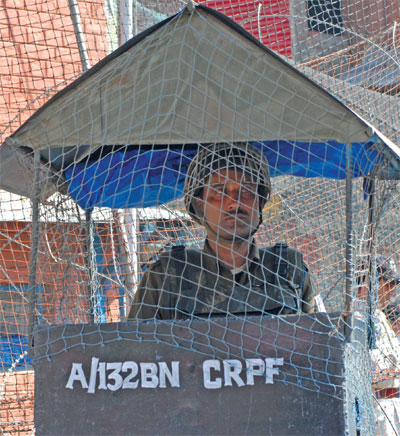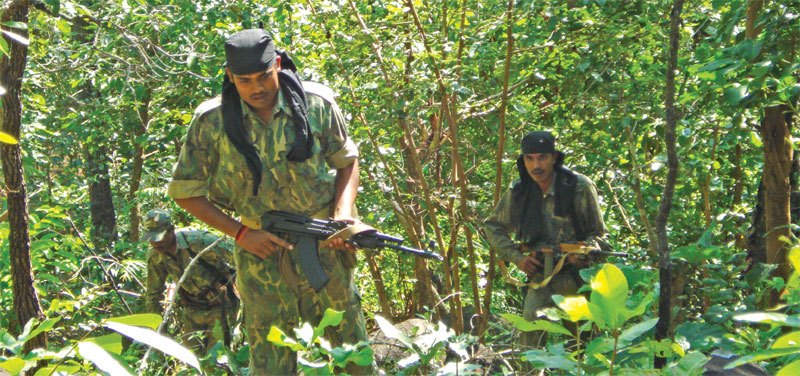Emotional distress among CAPF personnel is a matter of grave concern
Smruti Deshpande
During the budget session in March, the government informed parliament that 436 personnel died by suicide in the Central Armed Police Forces (CAPFs) and Assam Rifles in the last three years. According to the Ministry of Home Affairs (MHA), the maximum number of suicides in the were reported in the CRPF (154) while 111 suicides were from the BSF.
 Breaking down these numbers further, minister of state for home Nityanand Rai said in a written reply that of the 154 CRPF personnel, 54 died in 2020, 57 in 2021 and 43 in 2022. Of the 111 suicide incidents in the BSF, 30 personnel died in 2020, 44 in 2021 and 37 in 2022. Further in the CISF, 18 personnel died by suicide in 2020, 21 in 2021 and 24 last year. In the SSB, 18 personnel killed themselves in 2020, nine in 2021 and 13 in the last year. While in the ITBP, the number stood at 13 in 2020, 10 in 2021 and nine in the last year, in the Assam Rifles nine personnel died in 2020, 14 in 2021 and seven in 2022. In National Security Guard (NSG), two personnel died by suicide every year from 2020-23.
Breaking down these numbers further, minister of state for home Nityanand Rai said in a written reply that of the 154 CRPF personnel, 54 died in 2020, 57 in 2021 and 43 in 2022. Of the 111 suicide incidents in the BSF, 30 personnel died in 2020, 44 in 2021 and 37 in 2022. Further in the CISF, 18 personnel died by suicide in 2020, 21 in 2021 and 24 last year. In the SSB, 18 personnel killed themselves in 2020, nine in 2021 and 13 in the last year. While in the ITBP, the number stood at 13 in 2020, 10 in 2021 and nine in the last year, in the Assam Rifles nine personnel died in 2020, 14 in 2021 and seven in 2022. In National Security Guard (NSG), two personnel died by suicide every year from 2020-23.
The government even gave a 10-year report which said that over 1,205 paramilitary troopers died by suicide in the last 10 years. The CAPF comprises forces such as CRPF, BSF, CISF, ITBP, BSF, NSG and Assam Rifles (AR). Together, the strength of these forces is nine lakh personnel.
Earlier, in February a taskforce constituted by the MHA and headed by VSK Kaumudi, the special secretary (internal security) in the ministry, stated that discrimination among sub-groups, trauma of being abused, bullying at workplace, fear of initiation of disciplinary or legal action, lack of communication between company commander and jawans were some of the reasons why cases of suicide and fratricide were high in the Central Armed Police Forces (CAPFs).
Incidents of suicides and fratricides have been plaguing the paramilitary forces for the past several years now and the pandemic only worsened the problem as personnel were overworked with little or no rest.
Rai also revealed in the Rajya Sabha that there are 84,866 vacancies in the CAPFs. According to the government, vacancies in the CAPFs arise on account of retirements, resignation, promotion, death, raising of battalions, creation of new posts among others. Recruitment of 31,785 personnel in the CAPFs has been done in the past five months. A total of 247 positions for doctors have been lying vacant and the number of unfilled posts for nurses and other medical professionals stands at 2,354.
One of the primary reasons for the challenges faced by India’s paramilitary forces is inadequate funding and resources. This results in lack of modern equipment, training and infrastructure leading to decreased operational efficiency and effectiveness.
In several of its earlier reports, FORCE had elaborated upon the reasons the CAPFs are under immense strain. High operational tempo requires them to be deployed in challenging environments such as conflict zones, insurgency-affected areas and disaster-hit regions resulting in stress, fatigue and mental health issues among the personnel and affecting their performance. While guarding borders and internal security are these forces’ mainstay, they are even deployed for election duties, riot control and VIP duties.
The paramilitary forces in India face challenges in recruitment and retaining personnel because of various factors such as low pay, limited opportunities for lack of sleep and rest, career growth, and lack of adequate facilities such as housing for the personnel and their families.
These forces work alongside the regular military and other law enforcement agencies. However, coordination and cooperation between these agencies prove challenging. In fact, while the paramilitaries are required to function alongside the armed forces and face the same challenges on the work front, there is a yawning gap when it comes to perks. In comparison to the armed forces, leaves granted to paramilitary forces are half in number. While armed forces personnel are entitled to 60 days of annual leave, apart from 30 days casual leave, paramilitary personnel are entitled to just 15 days casual leave apart from 60 days of earned leave.
CAPF personnel find it hard to get even the promised leave on time because of the high number of vacancies—an obvious cause of stress. In comparison to the armed forces, the CAPFs don’t even get financial and promotional benefits. In case a jawan of the CAPF serving alongside the army gets injured or killed along with an army jawan, the quantum of benefits that the army jawan gets is much more. Even the canteen facilities that the CAPF personnel get are costlier than the canteen facilities that the armed forces are given. For instance, CAPF personnel do not get any GST exemption.
The Indian Express in one of its March reports quoted a source as saying that the task force found ‘leaves’ to be the main trigger in the CRPF, ITBP, BSF, SSB and the Assam Rifles. “Among the reasons for suicides, the task force recorded extended working hours, inadequate time to rest and recreation, lack of job satisfaction as compared with their counterparts in other sectors, sense of isolation and lack of social as well as familial support, and lack of robust grievance redressal mechanism,” the source told the newspaper. While there is dissatisfaction because of limited peace postings, one more relatively new reason for unhappiness is the New Pension Scheme.
The forces have started taking measures such as grievance redressal mechanisms and get-together such as ‘chaupal’, which aim to bring troops and officers together to discuss problems that the jawans may be facing. but there is still a long way to go for these measures to become efficient and for personnel to trust in them. While IGs and the DIGs have been instructed to ensure that the chaupal happens in an informal setting where the soldiers feel free to voice their concerns, it is the very nature of the duty that puts immense stress on the personnel, with a deterioration in their mental health.
Given all this, the MHA informed Parliament that 50,155 CAPF personnel quit jobs between 2018 to 2022. The year 2022 saw the highest attrition with 11,884 personnel quitting. During this period, the highest attrition was in the BSF followed by the CRPF while the lowest attrition was in the SSB. Between 2021 and 2022, the attrition in the Assam Rifles has increased from 123 to 537, in the CISF it has increased from 966 to 1,706 whereas in the SSB, it has decreased from 553 to 121.

Retired Additional DG of the BSF, Sanjiv Krishan Sood, says that apart from increasing work pressure and adverse working conditions, there is one grave issue in the form of faulty HR policies that the CAPFs are staring at. He says, “The government should look at bettering the HR policy. Jawans who joins the services today do not get promoted for 20-22 years. Similarly, an officer stagnates in the same position for 10-15 years. The government is not looking into these aspects.” Workload is a huge issue. He said in the BSF one workday runs into 15-16 hours.
He said the workload on the borders, especially on the eastern side, increases after the jawans are sent for additional duties such as elections. “These are contingencies where the government has to be supported but there are several other activities which are not useful such as cycle safari, camel safari and motorcycle shows among others. This reduces the strength on the borders adding to the workload,” he said. During the 50th anniversary celebrations of the independence of Bangladesh, Sood pointed out, one-third of the troops were withdrawn from the eastern borders. He said mahila constables should be utilised for the tasks they have been recruited instead of diverting them for peripheral tasks like motorcycle safari and cycle safari among other such events.
While Personnel Below Officer Ranks (PBORs) have started receiving house rent allowance (HRA), officers are yet to start benefitting from it. This, despite the Delhi High Court having questioned the MHA regarding it and having directed that every personnel in the paramilitary forces should be entitled to the benefit as per their entitlement.

